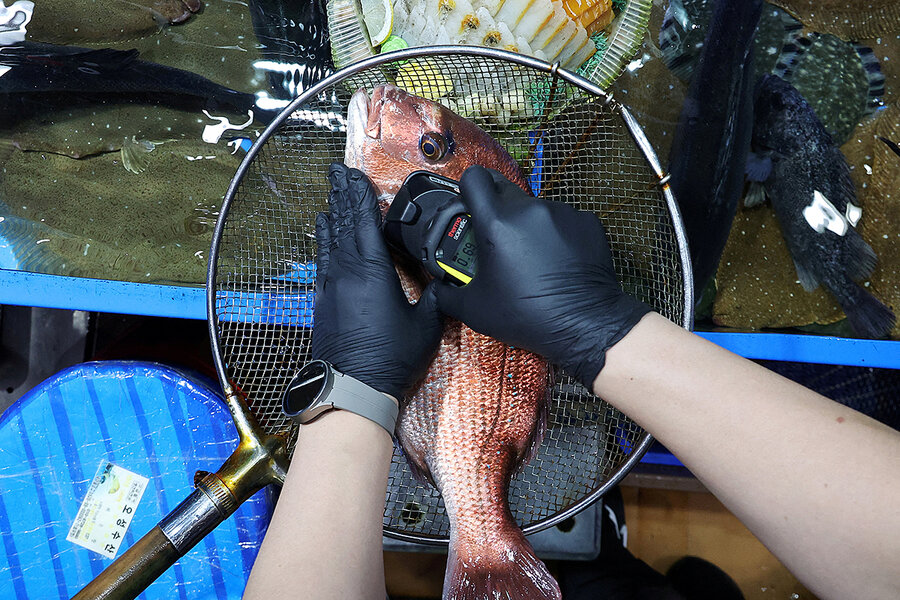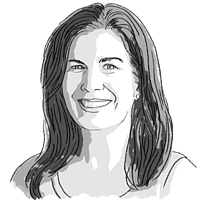Japan’s plan for Fukushima wastewater: Three questions
Loading...
Nations all over the world have long been discharging wastewater from nuclear facilities into the sea. Yet today, Japan’s plan to follow suit and release highly diluted, treated water from the Fukushima Daiichi nuclear power station – a plan recently deemed safe by the United Nations’ nuclear watchdog agency – has sparked opposition from governments and fishing communities.
Government officials and outside experts say the radiation level of the treated, diluted water will be low – “a few thousandths of the dose received in a single dental x-ray,” according to a government briefing. Still, surveys by local media of Fukushima residents show that more than 70% are concerned about reputational damage, stigma, and economic impacts from the release of the water.
Why We Wrote This
A story focused onIn Japan, plans to release treated wastewater from the Fukushima nuclear power plant have fishing communities and neighboring countries sounding alarms. But in this case, the fear doesn’t match the facts.
Indeed, Japan’s release of treated discharge water is “of zero significance for the health of the Pacific Ocean,” says Jim Smith, an environmental science professor and lead author of the book “Chernobyl: Catastrophe and Consequences.” But concerns about reputational damage are justified.
“The fishermen know very well that the perception of the risk will be really serious,” he says. “We’ve seen the same thing with Chernobyl – it’s that association with a terrible event” that creates fears, coupled with misinformation.
For decades, nations all over the world – from Canada and France to China and South Korea – have been discharging wastewater from nuclear facilities containing small quantities of radioactive materials.
Yet today, Japan’s plan to follow suit and release highly diluted, treated water from the Fukushima Daiichi nuclear power station – deemed safe by the United Nations’ nuclear watchdog agency – has sparked opposition from local and regional fishing communities and governments.
That opposition stems largely from fears – rather than facts – about Japan’s release, according to experts and surveys. The concern is that public perceptions about the risks of the discharge will harm fishing communities in Japan and surrounding countries. But scientific data backs up the conclusion of the International Atomic Energy Agency (IAEA), which is that Japan’s plans meet safety standards.
Why We Wrote This
A story focused onIn Japan, plans to release treated wastewater from the Fukushima nuclear power plant have fishing communities and neighboring countries sounding alarms. But in this case, the fear doesn’t match the facts.
Why is Japan releasing water from the nuclear power station into the sea?
When a massive 9.0 earthquake and tsunami hit Japan in 2011, the cooling system of the Fukushima plant was compromised. This led to the overheating of three reactor cores and the melting of nuclear fuel. Water inside the plant was contaminated with radioactive material. Since then, more water has been used in the cooling process, and rain and groundwater have seeped in.
The state-owned Tokyo Electric Power Co. (TEPCO) developed a method for treating the water to remove most – but not all – radioactive materials. Meanwhile, the plant has accumulated more than 1 million cubic meters of wastewater in storage tanks at the site.
The wastewater storage tanks occupy a large area, which hinders the ongoing work of decommissioning the Fukushima plant. And the tanks pose a risk of additional leaks due to age or natural disasters. After spending years studying disposal options, Japan announced in 2021 a plan to release the treated water gradually into the ocean in a series of controlled discharges spread over about 30 years.
Is the release safe?
The IAEA concluded in a recent report that Japan’s plans to release the treated water are consistent with the oversight body’s safety standards. Rafael Mariano Grossi, the IAEA director general, presented the report, nearly two years in the making, to Japanese Prime Minister Kishida Fumio in Tokyo on July 4.
“The controlled, gradual discharges of the treated water to the sea, as currently planned and assessed by TEPCO, would have a negligible radiological impact on people and the environment,” Mr. Grossi said in a foreword. The IAEA task force included agency specialists as well as “internationally recognised nuclear safety experts from eleven countries.” He stressed that the IAEA will continue its independent safety assessments throughout the discharge process, with an on-site presence and live online monitoring.
The main radioactive element in the water is tritium, a naturally occurring hydrogen isotope. “Everyone is exposed to small amounts of tritium every day,” according to the U.S. Nuclear Regulatory Commission, and no technology currently exists to remove the tritium from the water.
Simulations of Japan’s discharge plan showed that it was only within 3 kilometers of the station that tritium concentrations measured higher than those found naturally in seawater – beyond that, the water was no different from seawater anywhere else in the world. “If safety standards were not complied with, the Japanese would be the first ones to suffer from the consequences,” said a Japanese government official in a June briefing.
Japanese officials and outside experts say the radiation level of the treated, diluted water will be low – “a few thousandths of the dose received in a single dental x-ray,” according to a government briefing on the Fukushima plan. The level of tritium will be far below the World Health Organization limit for drinking water.
Why are some countries and fishing communities opposed?
While the G7 nations have backed the IAEA’s independent review of the safety of Japan’s plan, other countries, such as China and members of the Pacific Islands Forum, say Japan should take more time to study other options for dealing with the wastewater.
Japanese government officials say one reason they chose the sea discharge option is that many other countries around the world already discharge tritium in liquid waste from nuclear power plants into rivers and seas. In fact, the concentrations of tritium in water released from plants in China and South Korea are several times higher than the concentrations found in Japan’s plan.
Some environmental and marine groups oppose the plan. In the United States, the National Association of Marine Laboratories (NAML) said late last year that Japan’s scientific data was inadequate, and argued that dilution of the treated water may not stop radioactive elements such as tritium from accumulating in marine life.
Yet scientists with expertise in radioactive pollution disagree. Japan’s release of treated discharge water is “of zero significance for the health of the Pacific Ocean,” says Jim Smith, a professor of environmental science at the University of Portsmouth who has spent 30 years studying the environmental consequences of radioactive pollutants, including from the Chernobyl and Fukushima nuclear accidents. “It doesn’t bioaccumulate,” he says, citing long-term studies.
Meanwhile, fishing communities in Japan and South Korea are concerned that consumer fears of contaminated seafood will impact their livelihoods. Surveys by local media of Fukushima residents, for example, show that more than 70% are concerned about reputational damage, stigma, and economic impacts from the release of the water – rather than health effects. Concerns about reputational damage are justified, says Dr. Smith, who is the lead author of the book “Chernobyl: Catastrophe and Consequences.”
“The fishermen know very well that the perception of the risk will be really serious,” he says. “We’ve seen the same thing with Chernobyl – it’s that association with a terrible event” that creates fears, he says, coupled with misinformation.
To counter this, Japan has committed to conduct and publish regular sampling data to look for tritium in seafood caught in the Pacific east of Japan.










